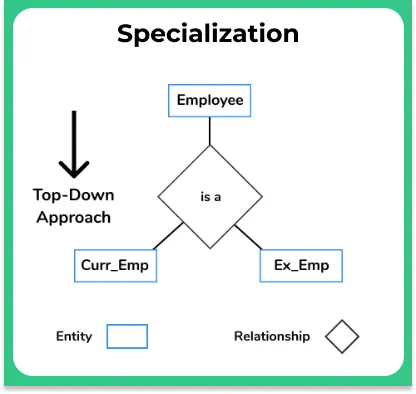0
Notifications Mark All Read
- Login
- Get Prime
Specialization in DBMS
Specialization in DBMS
On this page, we will learn about Specialization in DBMS.
The main purpose of specialization is to define subsets of entities that have few distinguishing features or attributes.

Specialization
- Definition: Specialization is a top-down design approach where one higher level entity can be broken into two or more lower level entities so that subsets of entities that share some distinguishing characteristics can be identified
- The specialization can be viewed as a reverse design process for generalization
Example: All types of employees in a company how common requirements or functionalities like name salary etc
The specialization is always done on a single entity over design it increases the schema size

Design steps for Specialization
- Generally, superclasses are defined first
- Define subclass and its related attributes
- IS-A Relationship is linked between these entities
Example for Specialization
- Consider an entity employee which consists of attributes name and salary, all types of employees like technician, engineer, accountant [ sub entities] have different roles in the company, but all employees working in a company have some common functionalities or requirements like salary, id iD, name, etc i.e these properties are common to all the employees
- Identified common properties are inherited from parent entity (employee) to submit entities(tester, accountant, engineer)
Conclusion:
- The main Idea behind specialization is the sharing of common properties between entities
- Specialisation is a top-down design process
Generalization V/S Specialization
Both generalization specialization are design procedures and are equally important in designing a schema
Let’s understand the key differences between the two.
| Generalization | Specialization |
|---|---|
| Purpose: Generalization identify the common among multiple entities landforms new entities. | Purpose: Specialization splits an entity to form multiple entities so that some features can be inherited from the split entity. |
| Design approach: proceeds in a bottom-up approach. | Design procedure: Proceeds in a top-down approach. |
| Size of schema: Generalization reduces the size of Schema. | Size of Schema: It increases the size of Schema. |
| Application: It is applied to a group of entities. | Application: It Is applied to a single entity. |
| Entities: Higher level entity must have a low-level entity. | Entities: The higher level entity may or may not have low-level entities. |
Prime Course Trailer
Related Banners
Get PrepInsta Prime & get Access to all 200+ courses offered by PrepInsta in One Subscription
Get over 200+ course One Subscription
Courses like AI/ML, Cloud Computing, Ethical Hacking, C, C++, Java, Python, DSA (All Languages), Competitive Coding (All Languages), TCS, Infosys, Wipro, Amazon, DBMS, SQL and others

 0
0



Login/Signup to comment